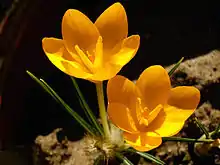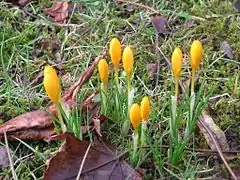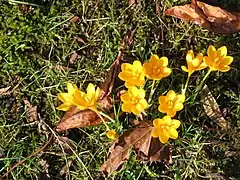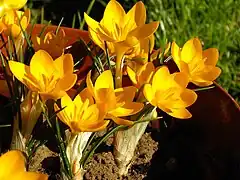| Crocus ancyrensis | |
|---|---|
 | |
| Scientific classification | |
| Kingdom: | Plantae |
| Clade: | Tracheophytes |
| Clade: | Angiosperms |
| Clade: | Monocots |
| Order: | Asparagales |
| Family: | Iridaceae |
| Genus: | Crocus |
| Species: | C. ancyrensis |
| Binomial name | |
| Crocus ancyrensis (Herb.) Maw | |
Crocus ancyrensis, sometimes known as the Ankara crocus,[1] (Turkish: Ankara çiğdemi) is a species of flowering plant in the genus Crocus of the family Iridaceae, endemic to North and Central Turkey.[2] It was named ancyrensis as it was first discovered in Ankara.[3]
Description
Crocus ancyrensis is a herbaceous perennial geophyte growing from a corm. Plants grow 4 to 6 inches tall.[4] The corms are oval shaped with fibrous reticulated tunics. The small flowers are 1 inch long and 0.5 ince wide are orange-yellow with orange-red stigmas.[5] The flowers have bright yellow throats and typically each corm produce two or three flowers.[4] Each corm has three or four leaves which appear during flowering.[4]
Habitat
The plant commonly flowers in the months of February to April, and is found growing at 1000–1600 meters in elevation.[3] It commonly grows near rocks, bushes and pines. Its corm, rich in sugar and starch, is edible; it has been a common staple in Anatolia.[6][7][8]
Cultivation
Crocus ancyrensis 'Golden Bunch' is a cultivar that was selected for its greater number of flowers than the typical species, with up to ten flowers per corm. It is one of the earliest yellows to bloom.[5] It is winter hardy in USDA zones 3 through 8.[4]
Gallery
References
- ↑ BSBI List 2007 (xls). Botanical Society of Britain and Ireland. Archived from the original (xls) on 2015-06-26. Retrieved 2014-10-17.
- ↑ "Crocus ancyrensis". Kew World Checklist of Selected Plant Families. Retrieved 2019-03-27.
- 1 2 "Ankara Çiğdemi (Crocus ancyrensis)" (in Turkish). Atılım Üniversitesi. Retrieved 2019-03-27.
- 1 2 3 4 Armitage, Allan M. (2008-05-01). Herbaceous Perennial Plants: A Treatise on their Identification, Culture, and Garden Attributes (3rd ed.). Cool Springs Press. ISBN 978-1-61058-380-0.
- 1 2 Jelitto, Leo (1990). Hardy herbaceous perennials. Wilhelm Schacht, Michael E. Epp, John Philip Baumgardt, Alfred Fessler. Portland, Or.: Timber Press. p. 168. ISBN 0-88192-159-9. OCLC 20012412.
- ↑ Füsun EHTUĞ. "Baharın Müjdecisi: Çiğdem (Crocus) ya da AN.TAH.âUMâAR Hititler Devri Anadolu Florasına Küçük Bir Katkı" (in Turkish). Turkish Academy of Sciences Journal of Archaeology. Archived from the original on 2019-03-27. Retrieved 2019-03-27.
- ↑ "Ankara Çiğdemi ve Çiçek Müzesi" (in Turkish). Hürriyet. 2012-08-07. Retrieved 2019-03-27.
- ↑ Iwona Kaliszewska and Iwona Kołodziejska-Degórska (2015-08-11). "The social context of wild leafy vegetables uses in Shiri, Daghestan". Journal of Ethnobiology and Ethnomedicine. NCBI. 11: 63. doi:10.1186/s13002-015-0047-x. PMC 4542102. PMID 26260575.


